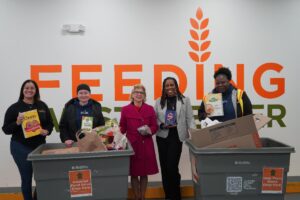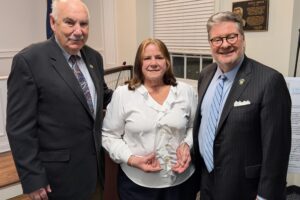Water, check. Phone, check. Anything else to pack for my yard safari – nope! Actually, I double check to make sure I have the iNaturalist app downloaded on my phone. With iNaturalist, you can snap a photo of an insect or plant or whatever it is you want to identify in nature, and then upload to the app to record your observation. The app will then offer suggestions for what the insect or plant is. While it helps you understand the natural world around you, your observations help contribute to biodiversity science and are shared with scientists to advance their research, a win-win.
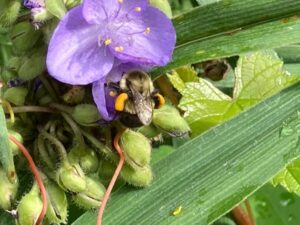 Here we go! First stop – checking out the plants around our rear yard patio. The native, purple-flowered Virginia spiderwort (Tradescantia virginiana) is in full force, buzzing with bumble bees at 8 a.m. this morning. This flower runs on a morning schedule, opening up at daybreak and closing shop at 10 a.m., when all of the petals wilt for the rest of the day. I snap a pic of a bumble bee diligently working, storing all of the orange pollen collected in its two “saddlebags” to take back home to feed the hive. Later when I upload this bumble bee pic, iNaturalist identifies this as a common eastern bumble bee, or Bombus impatiens.
Here we go! First stop – checking out the plants around our rear yard patio. The native, purple-flowered Virginia spiderwort (Tradescantia virginiana) is in full force, buzzing with bumble bees at 8 a.m. this morning. This flower runs on a morning schedule, opening up at daybreak and closing shop at 10 a.m., when all of the petals wilt for the rest of the day. I snap a pic of a bumble bee diligently working, storing all of the orange pollen collected in its two “saddlebags” to take back home to feed the hive. Later when I upload this bumble bee pic, iNaturalist identifies this as a common eastern bumble bee, or Bombus impatiens.
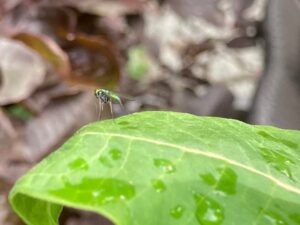 As I move my safari to the side yard, I catch this little fly sitting on a leaf with a bright green sheen when it catches the sun. When I look closer, I start seeing more colors, like blue, yellow and then the whole rainbow and am in awe of all that there is to observe on this one tiny fly. The iNaturalist community identifies this insect as belonging to the Parentia genus, otherwise known as a long-legged green fly.
As I move my safari to the side yard, I catch this little fly sitting on a leaf with a bright green sheen when it catches the sun. When I look closer, I start seeing more colors, like blue, yellow and then the whole rainbow and am in awe of all that there is to observe on this one tiny fly. The iNaturalist community identifies this insect as belonging to the Parentia genus, otherwise known as a long-legged green fly.
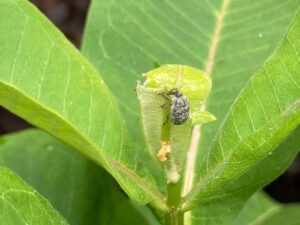 The next stop on my safari is the milkweed planting bed we have growing in the front yard. (Did I mention that our yard is a stop on the White Plains Pollinator Pathway?) I see what looks like a speck of dirt on the milkweed, but upon closer look I see little gray legs, a head, and a shell. iNaturalist helps me identify this insect as the milkweed stem weevil (Rhyssomatus lineaticollis). I research that it’s probably a female weevil, chewing holes through the milkweed as she lays one egg in each hole.
The next stop on my safari is the milkweed planting bed we have growing in the front yard. (Did I mention that our yard is a stop on the White Plains Pollinator Pathway?) I see what looks like a speck of dirt on the milkweed, but upon closer look I see little gray legs, a head, and a shell. iNaturalist helps me identify this insect as the milkweed stem weevil (Rhyssomatus lineaticollis). I research that it’s probably a female weevil, chewing holes through the milkweed as she lays one egg in each hole.
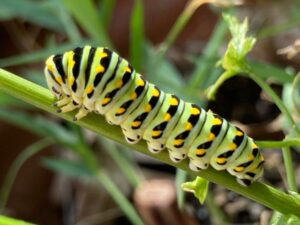 The final stop on the safari is a parsley planter we have right outside the kitchen door. I was so taken aback to see this magnificent caterpillar! iNaturalist identifies it as the caterpillar of a Black Swallowtail butterfly (Papilio polyxenes). This beautiful creature will be a caterpillar for 4 weeks, a chrysalis for 15 days, and then fly like a butterfly for its final life stage for only 1-2 weeks.
The final stop on the safari is a parsley planter we have right outside the kitchen door. I was so taken aback to see this magnificent caterpillar! iNaturalist identifies it as the caterpillar of a Black Swallowtail butterfly (Papilio polyxenes). This beautiful creature will be a caterpillar for 4 weeks, a chrysalis for 15 days, and then fly like a butterfly for its final life stage for only 1-2 weeks.
After the safari, I was sure to upload all findings to @planitwild’s iNaturalist account and help contribute as a citizen scientist.
For me, the most important thing about the safari was that by zooming in and seeing things up-close, it forced me to slow down and take in the moment, and notice how incredible a native garden is that increases our local biodiversity.
All photos by Amanda Bayley.
Amanda Bayley is the CEO & Co-Founder of Plan it Wild, a sustainable land management company that is bringing back native habitats to Westchester yards and commercial spaces. More Nature. Now. www.PLANitWILD.com



